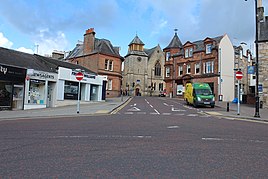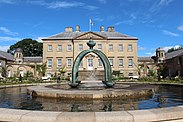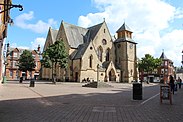Cumnock
| |
|---|---|
| Town and former civil parish | |
From top, left to right: Cumnock Town Centre, Dumfries House, bust of James Keir Hardie at Cumnock Town Hall, the "Old Church", Cumnock town centre and the Cumnock War Memorial | |
Location within East Ayrshire | |
| Population | 8,700 (2022)[1] |
| Language | English Scots |
| OS grid reference | NS569200 |
| • Edinburgh | 54 mi (87 km) |
| • London | 321 mi (517 km) |
| Council area | |
| Lieutenancy area | |
| Country | Scotland |
| Sovereign state | United Kingdom |
| Post town | CUMNOCK |
| Postcode district | KA18 |
| Dialling code | 01290 |
| Police | Scotland |
| Fire | Scottish |
| Ambulance | Scottish |
| UK Parliament | |
| Scottish Parliament | |
Cumnock (Scottish Gaelic: Cumnag) is a town and former civil parish located in East Ayrshire, Scotland. The town sits at the confluence of the Glaisnock Water and the Lugar Water. There are three neighbouring housing projects which lie just outside the town boundaries, Craigens, Logan and Netherthird, with the former ironworks settlement of Lugar also just outside the town, contributing to a population of around 13,000 in the immediate locale. A new housing development, Knockroon, was granted planning permission on 9 December 2009 by East Ayrshire Council.[2]
The town is home to the Robert Burns Academy, a new educational campus housing the main Robert Burns Academy secondary school following the merger of Cumnock Academy and Auchinleck Academy, Lochnorris Primary School and Cherry Trees Early Childhood Centre. The campus is the largest educational establishment in Scotland.[3]
The 2011 UK Census revealed that the Ayr, Carrick and Cumnock constituency, of which Cumnock is part, had an above-average unemployment rate at 5.6% compared to the Scottish average of 4.8%, with a significant proportion of residents living in local authority housing at 20.2% compared to the Scottish average of 13.2%. The constituency also had a high proportion of retired people and Church of Scotland Protestants at the Census relative to elsewhere in Scotland, with 19% of those living in the constituency retired (14.9% across Scotland) and 43.3% of constituents recognising their religion as Church of Scotland (32.4% across Scotland). 90% of residents identified their ethnicity as White British, with 99% recognising their ethnicity as White.[4] On indicators such as health, educational attainment, income and social class however the area is more deprived than the national average.
- ^ "Mid-2020 Population Estimates for Settlements and Localities in Scotland". National Records of Scotland. 31 March 2022. Retrieved 31 March 2022.
- ^ [1] [dead link]
- ^ Hilley, Sarah (8 October 2020). "Scotland's biggest school will be finished tomorrow in East Ayrshire". Daily Record. Retrieved 31 October 2021.
- ^ "Scotland's Census". Scotlandscensus.gov.uk.





